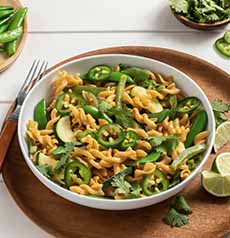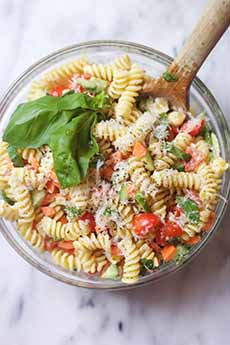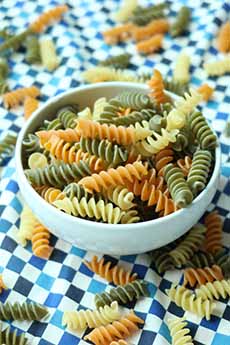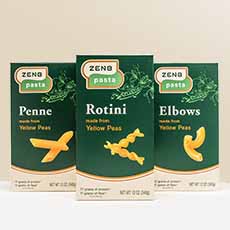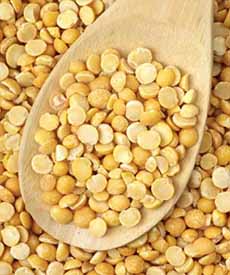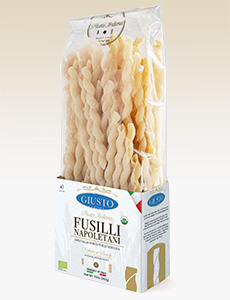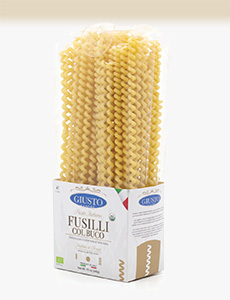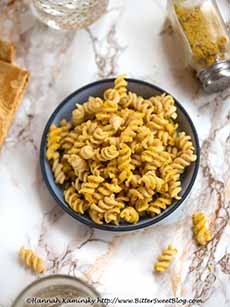Curry Pasta Primavera Recipe For National Curry Week
|
The first week in October marks the celebration of National Curry Week, a holiday begun in the U.K. 25 years ago. It was founded by a prominent journalist who had fallen in love with curry and wanted to create awareness of the burgeoning Indian restaurant industry, while also raising funds for charity [source]. Americans may not realize that curry is considered by some to be the “new” national dish of Britain*. Number one on the list for many years has been roast beef and Yorkshire pudding, followed closely by fish and chips. Will they be ousted? The British Raj—the ruxle of the British Crown in the Indian subcontinent between 1858 and 1947—led to the introduction of Indian cuisine to Britain. Chicken tikka masala and curry became popular dishes. According to the organizers of National Curry Week, millions of plates of curries are consumed every week in the U.K. > The history of pasta. Of course, you can use conventional wheat pasta in the recipe below. But here’s why you might want to try a box of ZENB yellow pea pasta, made in just about any shape you require. Yellow pea pasta is gluten-free and diabetic-friendly; equally important, it’s an excellent mimic of wheat pasta. And it helps to promote digestive health. Peas are one of the best sources of resistant starch, a form of starch that behaves like fermentable fiber, feeding beneficial bacteria. They also stimulate the production of the short-chain fatty acids that help protect against certain cancers, mitigate inflammation, and enhance satiety [source]. Yes, yellow pea pasta helps to promote digestive health (a key aspect of immunity), but it’s also delicious. The brand is gluten-free, vegan, non-GMO, and OU Kosher. The only ingredient is yellow peas (photo #5). This fusion dish combines pasta with vegetable curry—and it’s not just any pasta. It uses yellow pea pasta, which is gluten-free and more nutritious than conventional wheat pasta. The recipe is also vegan. Yellow pea pasta is very tasty, and we encourage you to try it. The recipe was created by a leader in yellow pea pasta, GENB. However, you can use conventional wheat pasta if you like. The pasta is mixed with vegetables in a yummy curry sauce and is ready in less than 30 minutes. The dish is also low in calories and low in fat. Says ZENB, “It will satisfy your curry and pasta cravings all in one dish!” In addition to the vegetables below (zucchini and bell pepper), other vegetables work well in this dish, including broccoli florets, carrots (sliced), cherry tomatoes, and sugar snap peas. You can use as many veggies as you like (we used five). Prep time is 10 minutes, cook time is 12 minutes. > See the difference between rotini and fusilli below. 1. COMBINE the pasta, water, and salt in a large skillet. Bring to a boil over medium-high heat. 2. STIR in coconut milk, curry paste, and salt. Continue cooking for 4 to 5 minutes until the sauce is thickened and the pasta is cooked through. 3. ADD the zucchini and peppers; cook for 3 to 4 minutes or until tender yet still crisp. 4. GARNISH with fresh herbs and chile slices, and lime wedge on the side. Rotini are short (two inches long), corkscrew-like shaped pasta. In Italy—actually, everywhere except the U.S. and Canada—they are called fusilli. Barilla sells the same product as rotini in the U.S. and fusilli in the U.K. It appears that the original corkscrew pasta, fusilli, was renamed rotini in North America. As to why, we were unable to find an answer. According to someone who has researched the subject if you ordered rotini in Italy and the rest of the world, no one would know what that was. Here’s more about it. Corkscrew pasta shapes are particularly popular with children but are also a great shape to catch sauces in the twists. Rotini work with most sauces, and in in pasta salads and baked pasta dishes. The corkscrew shape was invented in the Italian region of Campania, likely in Naples. Before industrial production capabilities, fusilli were made by wrapping fresh spaghetti around a thin rod or thick wire to dry. In fact, the word fusillo is from the Neapolitan dialect and refers to a rod that’s similar to a spindle, made by the blacksmith. Later, according to Italia Regina, pasta makers also used knitting needles and the spokes as disused umbrellas. The name of the shape derives from fuso†, a spindle or a thin pin on which something turns [source]. Fusilli means “little spindles.” Modern, industrial production of fusilli began in 1924. Two Italian emigrants in New York, Guido and Aurelio Tanzi, created a machine that produced quality fusilli efficiently. They have become one of the most popular cuts of pasta. Here’s more about the history of fusilli. In addition to conventional fusilli, there are: As with many short cuts of pasta, the shapes were designed to catch and hold as much sauce as possible. |
|
|
|
________________ *The national dish of Ireland is Irish Stew, a thick, hearty dish of mutton, potatoes, and onions. The national dish of Scotland is haggis, a sheep’s stomach stuffed with offal, suet, onions, and oatmeal into a loose sausage. The national dish of Wales is cawl, a stew made from bacon, lamb or beef, cabbage, and leeks [source]. As an aside, no particular food has been designated the national dish of the U.S., possibly because there are simply too many regional foods to choose from. If we had to pick, it would be the burger and fries—specifically, the cheeseburger, which accounts for about 70% of burger sales. †Note that there are numerous dialects spoken in different areas of Italy, and they are not typically noted in Italian-English dictionaries. ‡Chicken tikka masala is a dish created in the U.K. by British cooks of South Asian origin. Marinated chicken chunks are cooked in a spicy, creamy, bright orange or reddish sauce, the result of food coloring. The coloring—ratan jot, the root of Alkanna tinctoria—is a natural red dye that has no flavor and is used just for visual effect. It has been traditionally used as a food coloring in Indian recipes such as Kashmiri Rogan Josh and Tandoori Chicken. ‡‡Bucatini, also known as perciatelli, are a thick spaghetti-like pasta with a hole running through the center. The cut is common throughout Lazio, the region where Rome is located. CHECK OUT WHAT’S HAPPENING ON OUR HOME PAGE, THENIBBLE.COM.
|
||
